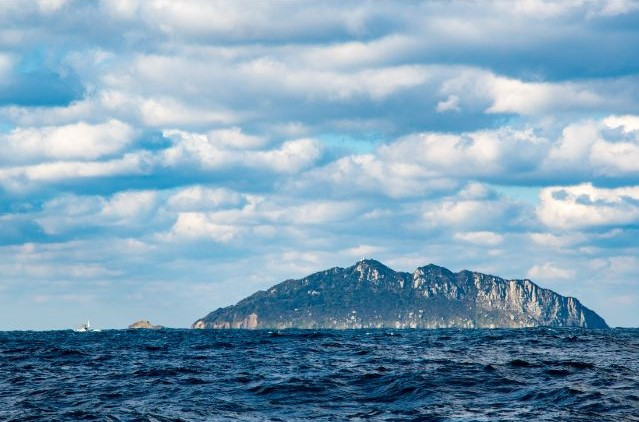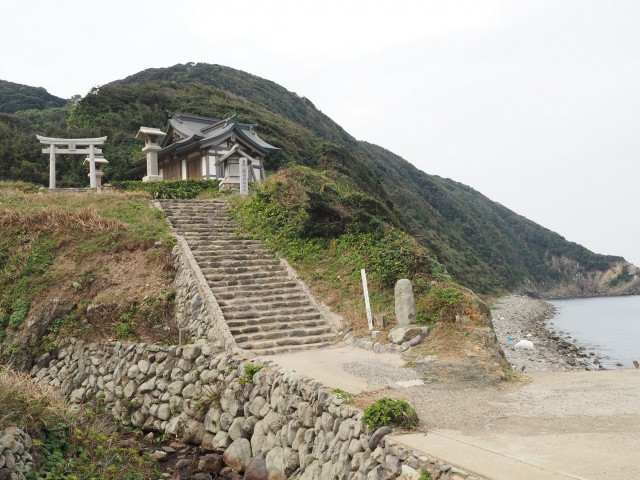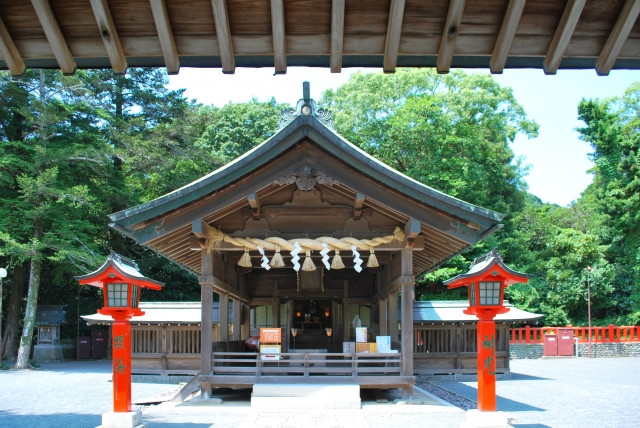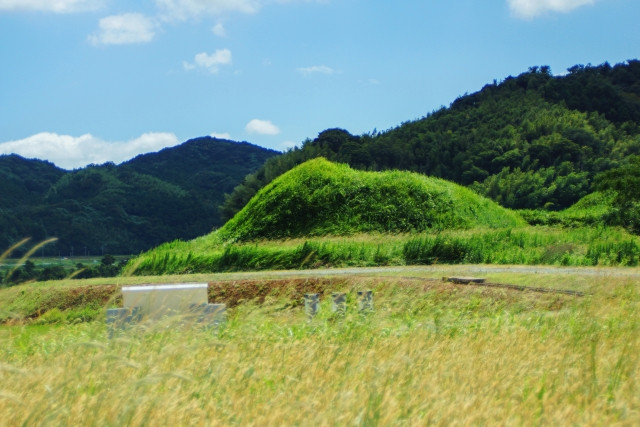Munakata City of Fukuoka Prefecture is home to four UNESCO World Heritage Sites collectively referred to as “Okinoshima and Associated Sites in the Munakata Region”. That’s a mouthful so let’s go with its common name, “Munakata Taisha”, 3 Shinto Shrines on separate islands including mystical God Dwelling Island.
Table of Contents
- All About Munakata History
- The Three Sacred Shrines of Munakata Taisha
- Detour to Fukutsu City: Shimbaru-Nuyama Mounded Tomb Group
- Takeaway
All About Munakata History
Munakata City of Fukuoka Prefecture in Kyushu offers visitors a glimpse of spiritual and religious culture in southern Japan. With several Word Heritage and historical sites, including the trio of Shinto shrines known collectively as Munakata Taisha (宗像大社), Munakata stands out as a city full of religion, culture, tradition, and most importantly, harmony with nature.
History
Munakata City was once a major economic center thanks to its strategic location close to other nearby countries. This was especially so from the years 400 to 900 when commercial and cultural relations with China, Korea, and others were flourishing. The Munakata Clan ruled over various travel routes and also religious sites and practices in the area. Unfortunately, the clan’s strong reign faced a downturn and eventually ended due to dying relations with China and Korea as China faced the end of the Tang Dynasty.
Munakata Taisha

UNESCO World Heritage Site Munakata Taisha consists of three shrines on three separate islands, these are Okitsu-miya on Okinoshima, Nakatsu-miya on Oshima, and Hetsu-miya on Kyushu Mainland.
The history of the three shrines can be dated back as early as the 4th century, mentions of the shrine can be found in 2 of Japan’s most ancient historical records, the Kojiki and the Nihon Shiki. According to the records, Sun Goddess Amaterasu broke her young brother Susanoo’s sword into three pieces. These three broken sword pieces were washed in one of the island’s spring waters, chewed, and breathed out, thus the three deities of Munakata Taisha were born!
※ UNESCO, “Sacred Island of Okinoshima and Associated Sites in the Munakata Region”
Writer's Pick
The Three Sacred Shrines of Munakata Taisha

1. Okitsu-miya on Okinoshima
The oldest of the three shrines, Okitsu-miya (沖津宮), is located on Okinoshima (沖ノ島). Access to the island and its shrine is strictly prohibited. It is believed that the deity Tagorihime no Kami, goddess of travel, still resides on this isolated island. There is only one inhabitant on the island at all times, a monk that takes care of the shrine and performs daily ceremonies. Altogether there are a group of 12 monks that take turns staying on the island for 10-days. The exception to this is May 27 when up to 200 men (no women sadly) can visit the island and shrine.
If you ever get the chance to visit the Island, keep in mind the rules and taboos:
-
Do not speak about what you’ve seen or heard to anyone.
-
Do not take anything off the island.
-
Bath nude in the sea for purification before alighting on the island.
Okinoshima is not just a sacred religious site; it is also a great archaeological success. Fully intact artifacts and relics from 400 to 900 AD were uncovered on the island. Some of these act as proof of the close trade and cultural relationship Munakata has with neighbouring countries.
Okitsu-Miya Yohaisho

Sometime in the early 18th century, this shrine was constructed in north Oshima to allow visitors to pray to cut-off Okinoshima. On a clear day, it is possible to see the mysterious Okinoshima in the distance.
2. Nakatsu-miya on Oshima

Fukuoka Prefecture’s largest island, Oshima (大島), is located 7 kilometers from the shores of Munakata City. This island is home to Tagitsuhime no Kami, the goddess of the sea. Nakatsu-miya (中津宮), her shrine, was established around the 16th century. Its Main Hall, a designated Fukuoka Prefecture Tangible Cultural Property, was rebuilt in the 17th century. Several small shrines from all over the island have been relocated to a centralized location around the Main Hall.
The highlights of this Island are as follows:
Mt. Mitake Ritual Site
Ancient ritual ceremonies used to be performed atop Mt. Mitake where the ritual site is. Though these rituals are no longer performed, you can still visit the peak of Mt. Mitake via a trail at the back of the Main Hall. The view from the summit is breathtaking, covering the Genkai-nada Sea, nearby islands, and coastlines.
Amanogawa and Tanabata Festival

Amanogawa connects to the Amanomanai Spring, this is the spring where Amaterasu was said to have washed the broken pieces of her brother’s sword. You can find the spring if you follow the path adjacent to the shrine’s office. Locals believe that the spring's waters have the power to bestow joy and long lives.
Another story that surrounds this river is the Tanabata Festival and its Legend of Star-Crossed Lovers (literally). Amanogawa represents the Milky Way that separates the lovers from each other, on both sides of the river are small shrines; Kengyu-sha (牽牛社; Hikoboshi; Altair) and Shokujo-sha (織女社; Orihime; Vega). The lovers are only able to reunite on the 7th day of the 7th month (Lunar Calendar) when a huge flock of magpies form a bridge over the Milky Way.
Access: From JR Togo or Fukuma Station, take the local bus to Konominato Hatoba Bus Stop. At Kaminatokotsen Terminal (Ferry Terminal), take the ferry to Oshima Harbour, then walk for 5-mins.
3. Hetsu-miya on Kyushu Mainland

Located in Munakata City, Hetsu-miya (辺津宮) is the most easily accessible among the three Munakata Taisha shrines. The shrine is located next to the Tsurikawa River and enshrines Ichikishimahime no Kami, the goddess of water. The current shrine buildings date back to the 12th century but there are strong signs that Shinto rituals have been performed here since the 7th century.
Behind the Main Hall, you can find 2 smaller shrines dedicated to the other 2 of the 3 female deities of Munakata Taisha. Technically, if you only visit Hetsu-miya and pray to all 3 of these shrines, you’d have completed a worship route of the 3 female deities and received their blessings. Woah!
Mt. Munakata Ritual Site
Beside the shrine building is a trail that leads up to Mt. Munakata. Similar to Nakatsu-miya’s Mt. Mitake Ritual Site, this is where Takamiya Saijo, an ancient ritual ceremony site is located. Though ceremonies are no longer held here, this site still holds significance to the shrine as all of the current rituals performed at Hetsu-miya originated from here. From atop the mountain is a panoramic view of the Tsurikawa River, Oshima, and Genkai Sea.
Shinpokan Museum
A three story treasure house found within the shrine grounds. Shinpokan Museum’s exhibits include National Treasures as well as uncovered artifacts from Okinoshima and Munakata Regions. Other historical artifacts can also be seen here including jewelry, pottery, glasswork, daily life instruments, and more. You can also learn about the Munakata Region and its previous reigning clan’s history here. The collection is extensive but do note that English language information is limited.
Entrance Fee: 800 yen (Adult), 500 yen (University Student)
※ Munakata Taisha, “Access - Shinpokan”
Uminomichi Munakatakan
This museum is free to enter. Exhibits include uncovered artifacts and a look at Munakata Region in its earlier years. The best thing about this museum is its 3D Theatre allowing visitors to experience closed-off entry-prohibited Okinoshima. Other things you can do here include joining a hands-on experience workshop to make Magatama or a flute.
Access: 3-mins walk from Hetsu-miya
NOTE
Closed on Mondays.
Detour to Fukutsu City: Shimbaru-Nuyama Mounded Tomb Group

Located in neighbouring Fukutsu City is the resting place of the Munakata Clan - Shimbaru-Nuyama Mounded Tombs. This group of mounded tombs is, along with Munakata Taisha and their islands, part of the UNESCO World Heritage Okinoshima and Assoc. Sites.
As mentioned in the History section above, the Munakata Clan have hugely contributed to the economical and religious development of the area. It is not an exaggeration to say they were responsible for the start, spread, and upholding of the sacred protection and worship of Okinoshima and its well-preserved state till this day. Altogether there are around 41 tombs belonging to the Munakata Clan in this area which can be dated back as early as the 5th century.
The plateau where the tombs were built have a view of the sea route leading up to Okinoshima. The observatory near the Visitor Centre on the east side offers great views of the sea.
Access:
-
10-mins drive from Hetsu-miya
-
From Munakata Taisha-mae Bus Station, take the local bus to Katsuurahama Bus station. Switch buses for one heading towards Camellia Stage, get off at Showa Gakuen-mae Bus Station.
We recommend taking a car, since public transport takes around 1.5-hours including 1-hour just waiting to transfer buses. It’s possible to time transfers just right for a total 35-mins travel time, but that’s very troublesome.
※ Okinoshima Heritage, “Shimbaru-Nuyama Mounded Tomb Group...on Okinoshima” ※ UNESCO, “Sacred Island of Okinoshima and Associated Sites in the Munakata Region”
Takeaway

A land of mystique and ancient Shinto practices, Munakata’s religious dedication and powers of preservation are truly a cut above the rest even in traditionalist Japan. Beautiful coastal city Munakata and its spiritual islands and mythical Gods provides a tranquil and spiritual experience for travelers. Or for non-believers, you can just enjoy the sights! It’s just as good!













.jpg)
















